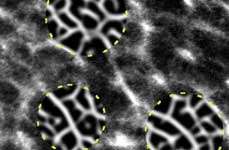Rubber possesses unique properties such as softness and stretchability, which are exploited in applications ranging from tyres to medical materials.
Molecular bonding forms a complex network structure that considerably influences the physical properties of rubber. However, the precise internal structure of rubber is not easily discerned in conventional electron microscope images because the outlines are obscured by noise.
Now, Yokohama Rubber, the University of Tsukuba, and the Japan Science and Technology Agency (JST) have developed a new image-processing method for electron microscope images that selectively enhances the visibility of areas in which rubber molecules aggregate into network-like structures.
By integrating knowledge of the rubber material with advanced mathematical techniques, the new method visually clarifies the internal network structure of rubber at the nanoscale, even in very noisy electron microscope images with unclear outlines.
The network region, which must be identified manually in conventional methods, can be calculated automatically by the new method, thereby eliminating the need for arbitrariness and enabling simultaneous analysis of multiple samples.
The researchers measured the network length of each sample using the new method. The processed data were highly correlated with the experimental values, thus confirming the new method’s reliability, the partners say.

